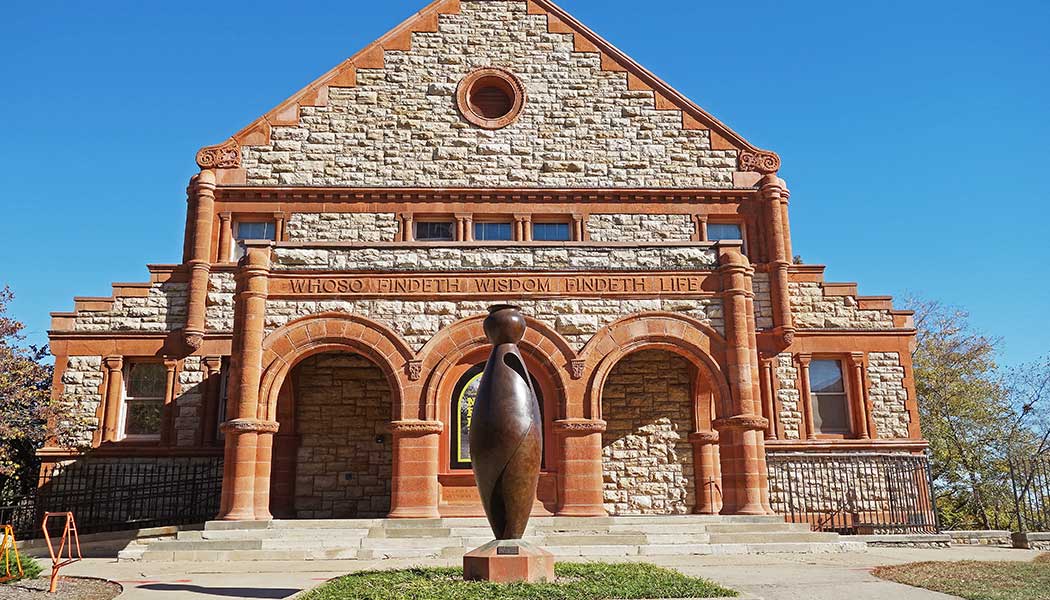KU partners with Native tribes to ensure regulatory compliance
Museum and collections officials focus on updated federal NAGPRA guidelines.
Among the items on display in the Spencer Museum of Art’s “Empowerment” gallery were natural-fiber baskets—from British Columbia, Northern California and two from southern Arizona—that celebrated the care and dedication Native North American artisans put into crafting simple household objects.
As visitors discovered early in the spring semester, however, the baskets’ plexiglass display cases now hang empty. “These artworks have been removed from display,” explains a wall card, “as we continue our work to comply with new regulations for the Native American Graves Protection and Repatriation Act (NAGPRA) that went into effect January 12, 2024.”
University and museum officials say the updated federal guidelines are complex in their details, yet boil down to a simple concept: Where once it had been up to Native tribes and communities to prove that an object was inappropriate for museum display, the burden of proof now falls to museums to confirm with tribes that objects in their collections comply with NAGPRA’s regulations and intent.
With uncertain provenance for the original acquisition (before coming into the Spencer collection) of two of the baskets, the museum chose to remove all four from display, pending further investigation.
“There’s a new section, called ‘duty of care,’ which provides additional guidelines for museums to follow to get consent on anything that could be NAGPRA-related,” explains Collection Manager Angela Watts, who came to KU in 2007 from Kansas City’s Nelson-Atkins Museum of Art. “We don’t have any evidence that those baskets were sacred, or objects of cultural patrimony, but we do want to go through a higher level of due diligence when we’re considering which works we put out on view.
“We want to make sure that everything was collected in an ethical manner and that the works were coming from artists who were willing participants in an art market.”
Tom Torma, who in 2023 left a similar position at the University of California, Berkeley, to sign on as KU’s repatriation program manager, joins Watts in emphasizing that while new regulations “have changed the NAGPRA landscape,” they have not significantly “changed much for what we want to do. I came on here knowing what the regulations would look like, so we’ve managed to structure the program in such a way that we’re a little bit ahead of the curve.”
Under NAGPRA’s updated regulations, Torma says, museums must “give priority to traditional tribal knowledge and tribal oral tradition.” Under the duty of care provisions, he explains, “there’s not much we can do with the collection if we don’t have permission from the tribes, so now tribes get to really kind of call the shots on what’s researched, where things are loaned, and how and where things are displayed. It’s a requirement to consult with them and ultimately get permission from them.”
Constant communication and consultation with tribes and Native artists is not only the right thing to do—“We have a moral imperative to do this,” Torma says, “and the direction I’ve been given is to follow that moral imperative”—but it also opens vast scholarship and research opportunities.
“We can partner with tribes and better serve an important constituency in the state of Kansas,” Torma says. “And, we improve the quality of our research so that it really does reflect the perspectives of the tribes.”
Adds Lori Hasselman, g’19, KU’s director of Native American & Indigenous Initiatives and a citizen of the Shawnee and Delaware Tribes of Oklahoma, “I really appreciate how we have come together to prioritize tribal sovereignty as we reflect on how we will build our relationships with tribal leaders coming to campus under these circumstances. As part of this process, we also continue to focus on caring for our Native community in more sustainable ways as we plan and implement Native wellness initiatives in the coming weeks.”
Watts notes that a unique privilege of her role as curator is that while handling objects as commonplace as a berry basket or clay cooking pot, “you can feel the love and the labor that have gone into doing something like this. That connection between an object that still exists now and the person who originally created it is definitely a strong feeling when you are in their presence. There are traces of the original maker there.
“It’s easy to see how those objects can still be so meaningful, and it’s definitely something we don’t take lightly.”
Chris Lazzarino, j’86, is associate editor of Kansas Alumni magazine.
/
